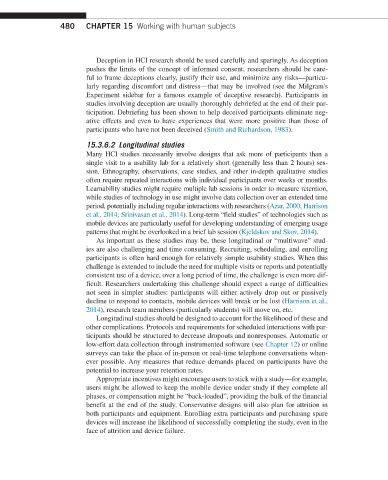Page 488 -
P. 488
480 CHAPTER 15 Working with human subjects
Deception in HCI research should be used carefully and sparingly. As deception
pushes the limits of the concept of informed consent, researchers should be care-
ful to frame deceptions clearly, justify their use, and minimize any risks—particu-
larly regarding discomfort and distress—that may be involved (see the Milgram's
Experiment sidebar for a famous example of deceptive research). Participants in
studies involving deception are usually thoroughly debriefed at the end of their par-
ticipation. Debriefing has been shown to help deceived participants eliminate neg-
ative effects and even to have experiences that were more positive than those of
participants who have not been deceived (Smith and Richardson, 1983).
15.3.6.2 Longitudinal studies
Many HCI studies necessarily involve designs that ask more of participants than a
single visit to a usability lab for a relatively short (generally less than 2 hours) ses-
sion. Ethnography, observations, case studies, and other in-depth qualitative studies
often require repeated interactions with individual participants over weeks or months.
Learnability studies might require multiple lab sessions in order to measure retention,
while studies of technology in use might involve data collection over an extended time
period, potentially including regular interactions with researchers (Azar, 2000; Harrison
et al., 2014; Srinivasan et al., 2014). Long-term “field studies” of technologies such as
mobile devices are particularly useful for developing understanding of emerging usage
patterns that might be overlooked in a brief lab session (Kjeldskov and Skov, 2014).
As important as these studies may be, these longitudinal or “multiwave” stud-
ies are also challenging and time consuming. Recruiting, scheduling, and enrolling
participants is often hard enough for relatively simple usability studies. When this
challenge is extended to include the need for multiple visits or reports and potentially
consistent use of a device, over a long period of time, the challenge is even more dif-
ficult. Researchers undertaking this challenge should expect a range of difficulties
not seen in simpler studies: participants will either actively drop out or passively
decline to respond to contacts, mobile devices will break or be lost (Harrison et al.,
2014), research team members (particularly students) will move on, etc.
Longitudinal studies should be designed to account for the likelihood of these and
other complications. Protocols and requirements for scheduled interactions with par-
ticipants should be structured to decrease dropouts and nonresponses. Automatic or
low-effort data collection through instrumented software (see Chapter 12) or online
surveys can take the place of in-person or real-time telephone conversations when-
ever possible. Any measures that reduce demands placed on participants have the
potential to increase your retention rates.
Appropriate incentives might encourage users to stick with a study—for example,
users might be allowed to keep the mobile device under study if they complete all
phases, or compensation might be “back-loaded”, providing the bulk of the financial
benefit at the end of the study. Conservative designs will also plan for attrition in
both participants and equipment. Enrolling extra participants and purchasing spare
devices will increase the likelihood of successfully completing the study, even in the
face of attrition and device failure.

